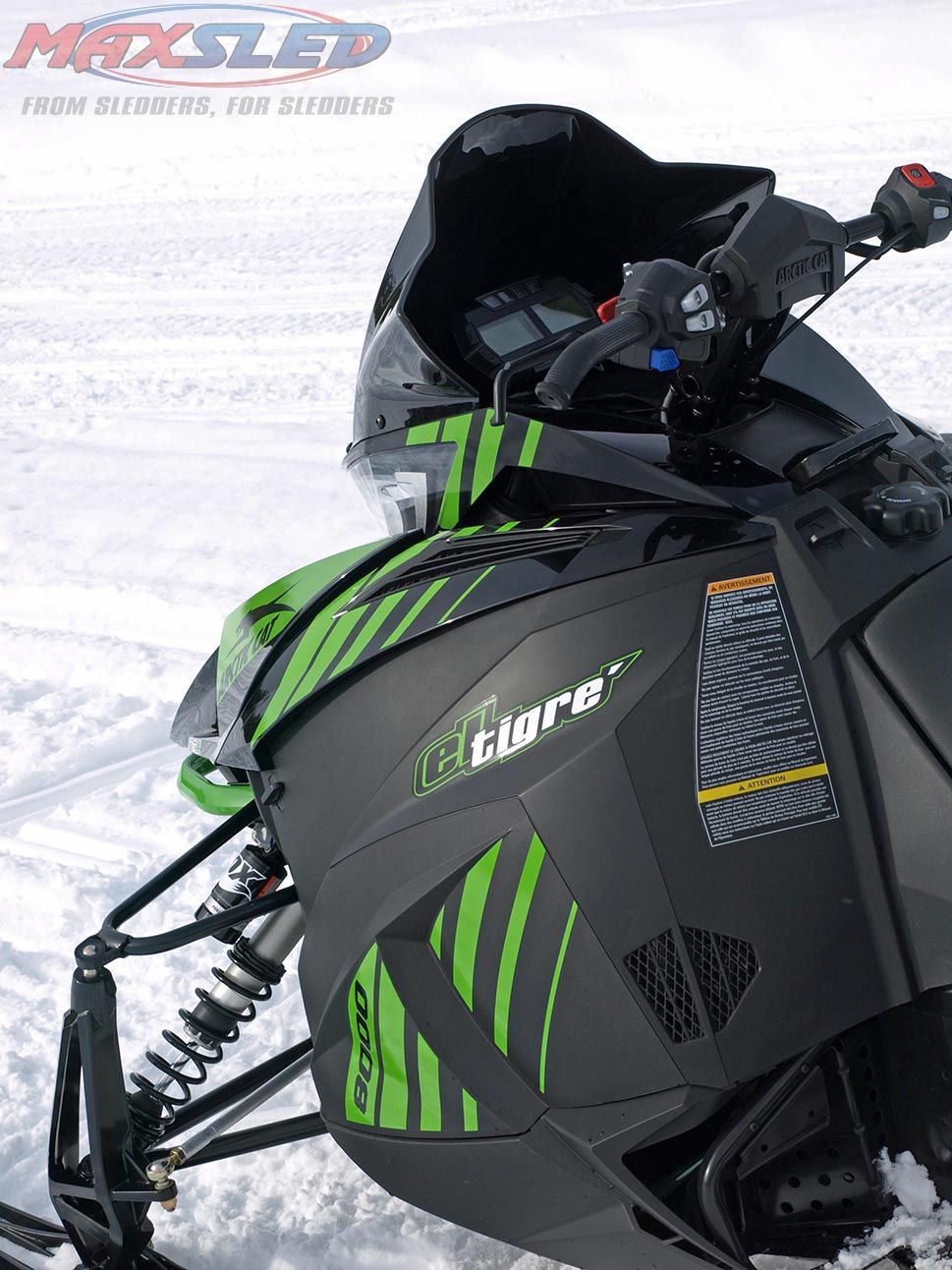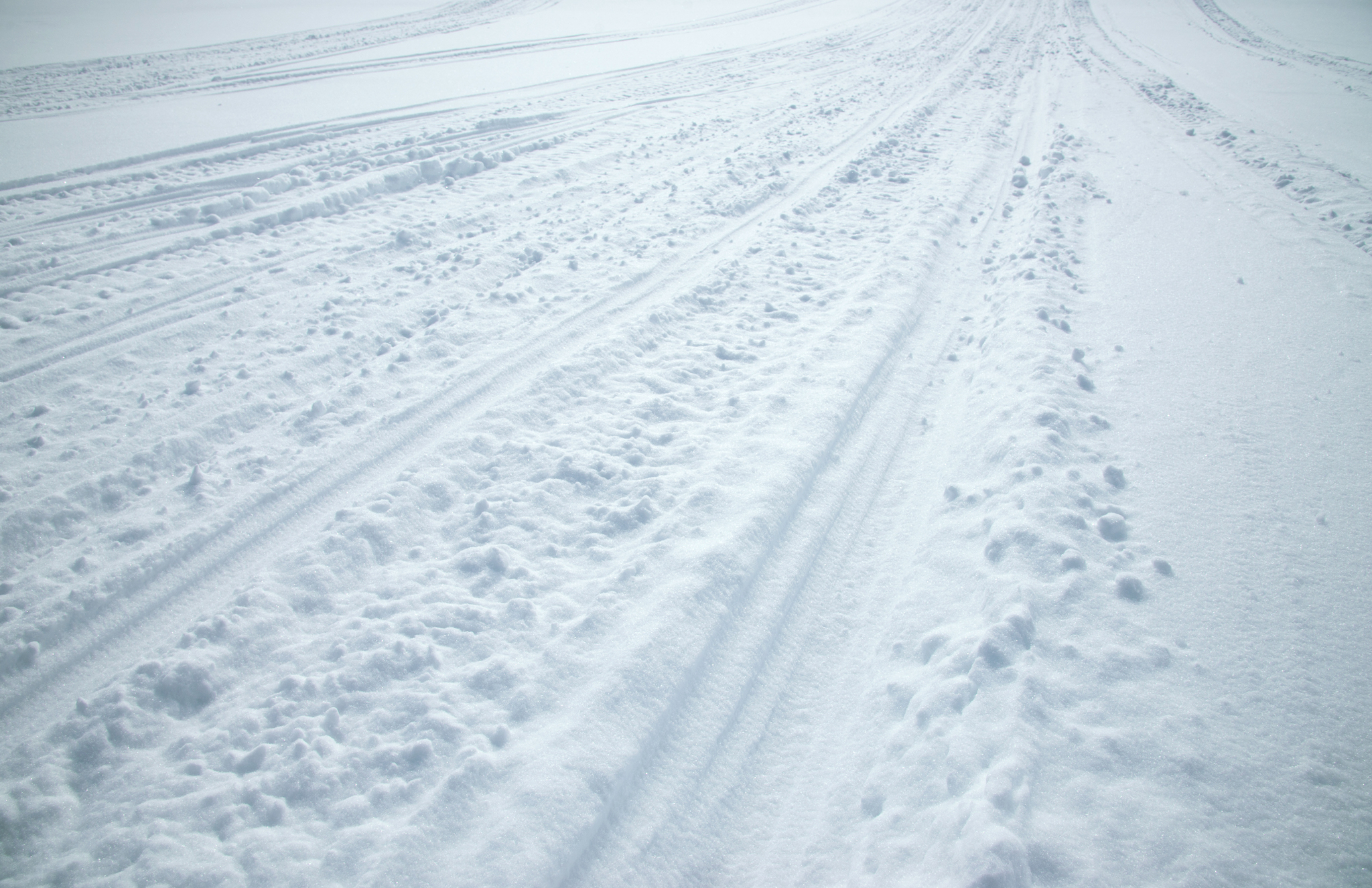
We learned from the 2017 XCR that this race-bred sled can stand abuse and with its supple Pro-XC suspension can handle big bang bumps on and of trails. JBassett photo.
How do two of 2018’s best flatland sportsters compare?

Maybe not the full-on trail ripper as its race replica sibling, the El Tigre ES is an excellent daily rider that’s easy to tune for varied trail conditions and ergonomically rewarding for long distance riding. JBassett photo.
When sport riders hit the Midwest’s trail system, they think big and fast. But at sea level 125-horsepower can be plenty “big” and fast enough for most of us. That’s why we’re concentrating on a comparison of Polaris’ 600 Rush XCR and Arctic Cat’s ZR 6000 Tigre ES 129. Make no mistake, these are true trail performance sleds with all the proper fundamentals to allow ample cornering thrills with satisfying power down all but the longest straightaway.
These two sleds compare well as they both have their manufacturer’s latest rendition of clean-burning, emissions-satisfying 600cc two-stroke twins. They deliver power via performance-tuned clutching. Their suspensions derive racetrack heritage but with individual engineering attributes.
Stylish and trail-ready for hardcore riding, these two “125-horsepower category” sport models sit in the sweet sport of modern performance trail sleds. Their goals may be similar, but it’s how they deliver that makes them unique.

At 129-inches the Cat’s Ripsaw track is longer than the XCR track, but has shorter 1.25-inch lugs. JBassett photo.
The El Tigre uses Cat’s own designed, engineered and St. Cloud, Minn. manufactured 6000 C-TEC2 two-stroke twin with its exclusive and unique Dual Stage Injection. It’s the basic design Team Arctic uses in its race sleds, just tuned for trail sports and not snocross. Don’t think you’re getting gypped as this 125-class horsepower power unit retains its quick-revving racer -like edge with DSI. At low revs, Cat’s computerized induction system uses an injector low on the cylinder to shoot 50 psi of fuel load into the crankcase where fuel charge is scavenged via transfer porting to the combustion chamber. With throttle input increasing and revs rising, the injector forces fuel directly through a slit in the piston skirt that’s aligned with a cylinder wall mounted injector. The design calls for a small amount of oil being fed into the fuel rail so there is constant lubrication for the piston pin and power takeoff bearings.
The success of the C-TEC2 DSI on Cat’s 6000 series twin led to Arctic Cat engineering evolving the concept for its new 800cc C-TEC2 DSI variant introduced for model year 2018.

The 2018 600 XCR, which remains essentially unchanged from the previous red and black 2017 model, now strikes its trail pose in bright blue. If you ordered early you could have gotten an ample variety of graphics choices thanks to the Polaris Snow Check program.
Polaris attacked the 600cc XCR power supply with more traditional engineering, using a 4-injector system seen in the 800cc Cleanfire two-stroke twin that is claimed to give the 600 engine a five-horsepower boost versus the 600cc twin with the 2-injector setup. Independent dyno-testing reveals this 4-injector twin with revised fuel mapping and an updated exhaust delivers just under 125-horespower at 7700 revs with 85 foot-pounds of torque.
Perhaps not as technically interesting as Cat’s DSI, the Polaris Cleanfire semi-direct injection gives you quick and crisp response. Plus, this latest 600 twin is designed specifically to “fit” the newer AWYS chassis in the same manner as was the 800 twin, which was engineered concurrently around this chassis design to maximize placement for what Polaris calls its “rider balanced control.” This is not a marketing gimmick, it’s real and you feel it on the trail from holeshot to corner turn in.
Interestingly both sled manufacturers turned to Team for clutching assistance. Polaris features a many generations evolved update of its historic P85 drive clutch with a race team proven Team LWT driven. Cat on the other hand works with Team for its entire Arctic Drive System, which features Team’s Rapid Response drive paired with Team’s Rapid Reaction driven. Both sleds are efficient and quick responding with consistent performance. We consider no advantage to either brand here.

The XCR’s 121-inch track spins around a Pro-XC suspension design that brings Polaris Race technology to the trail with “race-inspired” suspension components for increased durability and strength to ensure extreme performance. JBassett photo.
This Pro-XC rear suspension comes with geometry for the XCR’s progressive-rate rear suspension that is optimized for Polaris’ Rider-Balanced Control. The Walker Evans 2.0 front track shock was developed between Walker Evans and Polaris and reflects the need for a larger diameter to withstand higher speeds and increased oil volume for higher temperature operation.
Arctic Cat goes with its tried and true “slide-action” rear suspension. It gets its name from the action provided from a U-shaped slot that fits over a fixed shaft allowing a half-inch of sliding movement. As the rear transfer blocks are engaged, the suspension’s free-acting front arm can follow the terrain, keeping your skis firmly planted over bumps, and during aggressive cornering and acceleration. Plus, on full throttle acceleration it can allow cleaner holeshot reaction. Cat combines an internal floating piston (IFP) on the front arm with a quick-adjust, three-position Fox 2.0 Zero QS3 for the rear arm.
While both front suspensions are a double A-arm design, they differ in engineering. The El Tigre’s Arctic Race Suspension (ARS), the one we refer to as the tall spindle design, came directly from Team Arctic racing experience. So did the XCR’s Pro-XC, also an A-arm design but with shorter and lower-mounted control components.
To control its 9.3-inches of travel, the XCR adds exclusive to Polaris Walker Evans Hi/Lo Compression Adjustable Piggyback Needle Shocks with special “XCR valving” for improved tune-ability so you can adjust compression to suit your riding style. Aggressive but trail-worthy Pro-Steer skis complement the XCR’s front setup.

This 2018 El Tigre is sleeker thanks to its Next-Gen body panels that are easier to open and close, which makes an easy job of underhood servicing. JBassett photo.
The Cat’s ARS uses Fox 1.5 Zero QS3 shocks for easy adjustability and consistent performance. You won’t have as many tuning choices with the QS3 versus the Walker Evans shocks, but the Fox design will be perfectly suited for most riders looking for base comfort to a moderate action and up to full-on performance setting to control the El Tigre’s 10-inches of maximum travel. Cat marketing suggests setting the clicker to 1 for a smooth, comfortable ride like the LXR. Move up to 2 and you’ll straighten out the corners like a Sno Pro. Or click up to 3 to go head to head with an RR.
Gripping the trail shows a difference between the El Tigre 129 and the XCR as the Cat uses a 15-inch wide by 129-inch long Ripsaw design with 1.25-inch lug profile. The Polaris runs a shorter 121-inch long by 15-inch width rubber Cobra track with a more aggressive pattern with a taller 1.35-inch lug. You do the choosing as the shorter track has increased lug bite, but the longer 129-inch pairing on the Cat puts slightly more track on the trail.

Cat’s El Tigre offers easy-to-read digital instrumentation behind a mid-height windscreen. JBassett photo.
From a riding viewpoint, we like both of these sleds a lot. The Polaris AXYS chassis and its rider ergonomics fit us better for sporty trail action in the sweepers and twisties. It sits really well and seems a fraction quicker at turn ins when we want to ride hard. The Cat is an extremely pleasant ride and we appreciate the fuller accommodation of its runningboards versus the shortened ones necessitated by the Pro-XC rear suspension. Your final selection will come down to personal preference.

Polaris offers a wide variety of add-ons for its sleds that include taller windshields, storage options and even the Polaris Interactive Digital Display (PIDD) for on-trail navigation, Bluetooth functionality and so on. JBassett photo.
Note, too, that the El Tigre’s higher price includes standard electric start. We’d like it on the XCR, which would bring the pricing closer. As for options, the Polaris can be fitted with Polaris interactive digital display for on-trail navigation, Bluetooth functionality and so on. You can add an optional “rump roaster” heated seat to the El Tigre. Everything else is purely personal preference as to styling, windshield height and effectiveness, on board storage and overall ride ergonomics.
As we noted, the two sleds serve a similar purpose, but go about it in different ways. Which suits you better?
